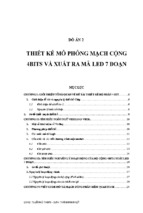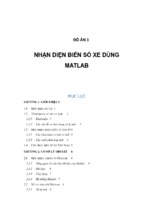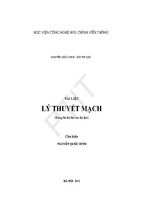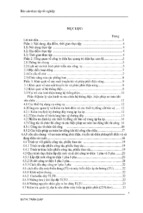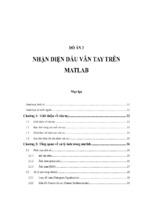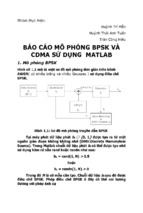Department of mathematics
Degree project in mathematics
Kalman filtering
With a radar tracking implementation
Author: Fredrik Svanström
Examiner: Prof. Börje Nilsson
Semester and credits: VT13 15hp
Course code: 2MA11E
Abstract
The Kalman filter algorithm can be applied as a recursive estimator of the
state of a dynamic system described by a linear difference equation. Given
discrete measurements linearly related to the state of the system, but
corrupted by white Gaussian noise, the Kalman filter estimate of the system
is statistically optimal with respect to a quadratic function of the estimate
error.
The first objective of this paper is to give deep enough insight into the
mathematics of the Kalman filter algorithm to be able to choose the correct
type of algorithm and to set all the parameters correctly in a basic
application. This description also includes several examples of different
approaches to derive and to explain the Kalman filter algorithm.
In addition to the mathematical description of the Kalman filter algorithm
this paper also provides an implementation written in MATLAB. The
objective of this part is to correctly replicate the target tracker used in the
surveillance radar PS-90. The result of the implementation is evaluated
using a simulated target programmed to have an aircraft-like behaviour and
done without access to the actual source code of the tracker in the PS-90
radar.
Keywords: Kalman filter, Radar tracking
III
Table of contents
Abstract _____________________________________________________ III
Table of contents ____________________________________________ IV
1. Introduction ________________________________________________ 1
1.1 Background ______________________________________________ 1
1.2 The objectives of this paper __________________________________ 3
1.3 Limitations _______________________________________________ 4
2. The Kalman filter algorithm ___________________________________ 5
2.1 Background and basics _____________________________________ 5
2.2 The mathematics of the Kalman filter algorithm __________________ 8
2.3 Derivations of the Kalman filter algorithm, different approaches ____ 13
2.3.1 Orthogonality property _________________________________ 13
2.3.2 Minimizing the error covariance __________________________ 14
2.3.3 The low-pass filter approach _____________________________ 15
2.3.4 Maximum likelihood ___________________________________ 15
2.3.5 Bayesian or conditional probability approach _______________ 16
2.3.6 The Riccati equations __________________________________ 16
2.3.7 Chi-square approach ___________________________________ 17
2.3.8 Matrix inversion lemma ________________________________ 17
2.3.9 Pythagorean Theorem __________________________________ 18
2.4 Beyond the Kalman filter algorithm __________________________ 19
2.4.1 The extended Kalman filter _____________________________ 19
2.4.2 Other variants ________________________________________ 20
3. Method ___________________________________________________ 21
4. Implementation of a Kalman filter based radar tracker ___________ 22
4.1 The order of the filter ______________________________________ 22
4.2 Definitions of the vectors and matrices ________________________ 22
4.3 Measurement to track association and target maneuver detection ____ 24
5. Results and analysis _________________________________________ 26
6. Summary and discussion _____________________________________ 30
7. References _________________________________________________ 31
8. Appendices ________________________________________________ 34
IV
1. Introduction
Ever since it was formulated, the Kalman filter algorithm has been used in a
wide variety of areas. My first encounter with it was in the automatic target
tracker used in the surveillance radar PS-90.
From now on in this paper the Kalman filter algorithm will be referred to as
the KFA.
1.1 Background
The surveillance radar PS-90 (Giraffe 75) is the 2nd generation of Giraffe
radar stations manufactured by SAAB Electronic Defence Systems
(formerly Ericsson Microwave). The PS-90 was developed and produced in
the latter half of the 1980s and has been used by the Swedish army since the
beginning of the 1990s. The PS-90 has a maximum range of 50 km.
Figure 1.1 The surveillance radar PS-90
1
Fredrik Svanström
In Reparationsbok radar PS-90 (2003), i.e. the maintenance manual, the
tracking of targets is described as being performed by a Kalman filter.
After being processed in the receiver and signal processing of the PS-90, the
inputs to the target tracker are the measured ranges and azimuths to the
targets. These measurements will be corrupted by noise depending both on
the targets, the environment of the radar and the construction of the radar
itself. To make things even more complicated, the tracker must also be able
to handle occasional false targets due to clutter and background noise, as
well as voluntary and involuntary jamming of the radar. The interval
between two consecutive measurements inputs is 1 Hz, as determined by the
normal antenna revolution speed of 60 rpm.
The output of the tracker consists of the north orientated Cartesian
coordinates of the targets together with the north and east components of the
target velocities. Output target data is sent over the communications network
at a rate of about 10 Hz.
Figure 1.2 The PPI of the PS90
The tracker in the PS-90 handles target with speeds up to 1000 m/s and
targets maneuvering with an acceleration of up to 60 m/s2 (about 6g).
2
Fredrik Svanström
Summing up the challenges involved in constructing a radar tracker for the
PS-90 we are facing the following:
The input target positions are corrupted by measurement noise
The measurements can be considered as “a fraction of a second old”
due to delays in the signal processing
More dimensions of information are being sent out from the tracker
than available in the input
The output rate of target data is higher than the input rate
Several target can appear within the range of the radar at the same
time
This can be seen as a typical situation suited for a KFA implementation.
A more technical description of the PS-90 is found in appendix 1.
Other examples of practical solutions to the radar target tracking problem
are found in appendix 2. I have also found some applications of the KFA in
other systems besides radar trackers, these are described in appendix 3.
1.2 The objectives of this paper
The objective of the first part of this paper is to give an insight into the
mathematics of the Kalman filter algorithm. The purpose of this is to be able
to make an implementation of the algorithm and to adapt the variables and
parameters in a correct way to suite an arbitrary application. Included in the
mathematical description is also a survey of the literature giving an insight
into how the KFA appears in diverse fields of mathematics and how it can
be derived from different points of views. The pedagogical approaches of
the references are also considered to see how examples, simplifications or
relations to other known mathematical concepts are used to introduce and to
explain the KFA. A key result of the first part is also to be able to choose
what type of KFA to use in the second part of this paper.
The second part is devoted to making a MATLAB implementation of the
KFA using conditions similar to those specified for the PS-90 target tracker.
This will be done without access to the actual source code of the tracker in
the PS-90 and evaluated using a simulated target with an aircraft-like
behaviour. The objective of this part is to make the implementation
consistent with the behaviour of the PS-90 tracker.
The m-file tracker.m can be found in appendix 4.
3
Fredrik Svanström
1.3 Limitations
One of the differences between the PS-90 and the 1st generation Giraffe
radar station (The PS-70/Giraffe 40), is that the PS-90 has a dual feeding
horn mounted in front of the antenna reflector. This allows the PS-90 to get
a rough estimate of the altitude of the target. The MATLAB target tracker in
this paper will not include any altitude information.
In sever jamming or clutter conditions the radar operators working in the
PS-90 can support the target tracker manually. This will not be possible in
the MATLAB tracker.
Only one target will be handled by the MATLAB tracker instead of the
maximum of 20 that can be handled by the tracker in the PS-90.
The same computer handling target tracking in the PS-90 also handles track
initiation and tracking of jam strobes, this will not be covered by this paper
or be incorporated in the MATLAB tracker. When no detection of a target
inside the track association window has been made for 12 consecutive
seconds, the target track in the PS-90 is terminated. During the last six
seconds the tracking symbol is flashing to make the crew aware of the
possible termination. The MATLAB implementation will not have a track
termination part.
4
Fredrik Svanström
2. The Kalman filter algorithm
2.1 Background and basics
Since the original article of Rudolph E Kalman (1960), the algorithm now
bearing his name, can be found in many practical applications whereof radar
tracking is just one. However, by studying the history of the KFA, it is clear
that it just as well could have been called the Swerling filer algorithm since
Peter Swerling actually described a similar method two years before
Kalman. Sorenson (1970) describes this controversy.
The KFA can be applied as an estimator of the state of a dynamic system
described by the linear difference equation
𝒙𝑘 = 𝐀 𝑘−1 𝒙𝑘−1 + 𝐁𝑘−1 𝒖𝑘−1 + 𝒘𝑘−1 ,
where the matrix 𝐀 𝑘−1 is the relationship between the state of the system,
described by the column vector 𝒙𝑘−1 at time k-1 and the state 𝒙𝑘 at time k.
The column form of a vector is considered to be the normal form in this
paper and a transpose into a row vector will be denoted by T, this is also the
notation used for the transpose of matrices. The matrix 𝐁𝑘−1 relates the
optional control input vector 𝒖𝑘−1 to the state and the vector 𝒘𝑘−1 is the
process noise. In general, matrices will be denoted by uppercase bold letters
and vectors by lowercase bold italics.
The system is then measured at discrete points in time where the
measurement vector 𝒛𝑘 is related to the true state of the system by the
equation
𝒛𝑘 = 𝐇𝑘 𝒙𝑘 + 𝒗𝑘 ,
where the vector 𝒗𝑘 represents the measurement noise and 𝐇𝑘 is the
observation matrix, which makes it possible to have more
parameters/dimensions in our estimate than we are actually getting from our
measurement inputs. The PS-90 target tracker described in this paper can
serve as an excellent example of this fact, as the radar is measuring only
position, while the KFA estimates and predicts both the position and the
velocity of the target.
The process noise 𝒘𝑘−1 and the measurement noise 𝒗𝑘 are assumed to be
independent of each other and normal distributed with zero mean. As an
example, if we are measuring the value of a resistor, the process noise will
be the inaccuracy caused by the manufacturing process and the measurement
noise will be the error of the ohm-meter used. These two errors are clearly
independent of each other.
5
Fredrik Svanström
From these two noise vectors the system noise covariance matrix 𝐐𝑘−1 =
E(𝒘𝑘−1 𝒘T𝑘−1 ) (where E denotes the expected value) and the measurement
noise covariance matrix 𝐑 𝑘 = E(𝒗𝑘 𝒗T𝑘 ), are formed. Here, and in the
following 𝒗𝑘 𝒗T𝑘 is interpreted as the matrix multiplication of the column
vector 𝒗𝑘 and the row vector 𝒗T𝑘 .
Just like the method of least squares, the KFA estimation of the system is
statistically optimal with respect to a quadratic function of the estimate error,
𝑁
min ∑(𝑠𝑘 − 𝑠̂𝑘 )2 ,
𝑘=1
where 𝑠𝑘 is the true state of some system and 𝑠̂ 𝑘 is the estimate of the same.
As seen in section 2.3.2 this will be equivalent to minimizing the trace of the
error covariance matrix 𝐏𝑘∣𝑘 of the estimate 𝒙̂ 𝑘∣𝑘 ,
̂𝑘∣𝑘 , 𝒙𝒌 − 𝒙
̂𝑘∣𝑘 ) = E[(𝒙𝒌 − 𝒙
̂𝑘∣𝑘 )(𝒙𝑘 − 𝒙
̂𝑘∣𝑘 )T ].
𝐏𝑘∣𝑘 = cov(𝒙𝒌 − 𝒙
̂𝑘∣𝑘 is referred to as the a posteriori estimate since it is
The estimate vector 𝒙
an estimate of the system at time k calculated including the measurement
̂𝑘∣𝑘−1 , which is an
𝒛𝑘 . This differs from the a priori estimate, denoted 𝒙
estimate of the state at time k made only with the available measurements up
to k-1, but not including the latest measurement 𝐳k . This notation is also
used, having the same meaning as above, to separate the error covariance
matrices 𝐏𝑘∣𝑘 and 𝐏𝑘∣𝑘−1 , as well as separating the error vector of the
̂𝑘∣𝑘 from 𝜺𝑘∣𝑘−1 = 𝒙𝑘 − 𝒙
̂𝑘∣𝑘−1.
estimate 𝜺𝑘∣𝑘 = 𝒙𝑘 − 𝒙
The different steps of the KFA are seen in figure 2.1 (the figure is based on
Kim (2010)). The notation of the steps in the KFA described by figure 2.1
will be used throughout this paper. The matrix for the Kalman gain 𝐊 𝑘 will
be defined in section 2.2.
̂0 and the matrix 𝐏0 ,
After initiating the algorithm (step 0) using the vector 𝒙
the KFA can be divided into a prediction part (step I) and a correction part
(steps II-IV).
6
Fredrik Svanström
The 5 steps of the KFA
0 Setting the initial values
̂0 , 𝐏0
𝒙
I Prediction of the state and error covariance
̂𝑘∣𝑘−1 = 𝐀 𝑘−1 𝒙
̂𝑘−1∣𝑘−1
𝒙
𝐏𝑘∣𝑘−1 = 𝐀 𝑘−1 𝐏𝑘−1∣𝑘−1 𝐀T𝑘−1 + 𝐐𝑘−1
II Computation of the Kalman gain
𝐊 𝑘 = 𝐏𝑘∣𝑘−1 𝐇𝑘T (𝐇𝑘 𝐏𝑘∣𝑘−1 𝐇𝑘T + 𝐑 𝑘 )−1
Measurement
𝒛𝑘
III Computation of the estimate
̂𝑘∣𝑘 = 𝒙
̂𝑘∣𝑘−1 + 𝐊 𝑘 (𝒛𝑘 − 𝐇𝑘 𝒙
̂𝑘∣𝑘−1 )
𝒙
IV Computation of the error covariance
𝐏𝑘∣𝑘 = 𝐏𝑘∣𝑘−1 − 𝐊 𝑘 𝐇𝑘 𝐏𝑘∣𝑘−1
Figure 2.1 The structure of the Kalman filter algorithm
7
Fredrik Svanström
Estimate
̂𝑘∣𝑘
𝒙
2.2 The mathematics of the Kalman filter algorithm
Consider 𝒵𝑘−1 as the vector space spanned by all of the available
measurements 𝒛𝑛 where 1 ≤ 𝑛 ≤ 𝑘 − 1, so 𝒵𝑘−1 = span {𝒛1 , 𝒛2 , 𝒛3 , … , 𝒛𝑘−1 }
and since we have a finite set of measurements 𝒵𝑘−1 can be regarded as a
finite-dimensional subspace of the vector space of all possible
measurements.
Using the Gram-Schmidt process an orthogonal basis 𝒆0 , 𝒆1 , … , 𝒆𝑛 for the
vector space 𝒵𝑘−1 can be formed and any new vector 𝒙𝑘 , not necessarily in
𝒵𝑘−1 can therefore be written as a linear combination of this orthogonal
̃𝑘 orthogonal to 𝒵𝑘−1 ,
basis plus a residue 𝒙
𝑘−1
̃𝑘 .
𝒙 𝑘 = ∑ 𝑎 𝑛 𝒆𝑛 + 𝒙
𝑛=1
By the method of least squares we know that the best estimate in this sense
of 𝒙𝑘 , using any linear combination of vectors in 𝒵𝑘−1 will be an orthogonal
projection of 𝒙𝑘 onto 𝒵𝑘−1 , as illustrated in figure 2.2.
Figure 2.2 The orthogonal projection of xk onto 𝒵𝑘−1.
Using these properties of orthogonal projections we now focus on the
derivation of the KFA. To simplify the illustration of the mathematical ideas
the measurement, the estimate and the true state of the system are assumed
to be of the same dimension and the observation matrix is the identity
matrix.
8
Fredrik Svanström
̂𝑘∣𝑘−1 and illustrated in figure 2.3, will
Our best a priori estimate, denoted 𝒙
be the true state of the system, 𝒙𝑘 , orthogonally projected onto the vector
space spanned by all our earlier measurements and the error of the estimate
̂𝑘∣𝑘−1.
will be 𝜺𝑘∣𝑘−1 = 𝒙𝑘 − 𝒙
̂𝑘∣𝑘−1 with its error 𝜺𝑘∣𝑘−1
Figure 2.3 The a priori estimate 𝒙
Given a new measurement vector 𝒛𝑘 , take the part of 𝒛𝑘 that is orthogonal to
the vector space 𝒵𝑘−1 , and call this 𝒛̃𝑘 . In some literature, for example Kay
̂𝑘∣𝑘−1 .
(1993), 𝒛̃𝑘 is called the innovation and can be seen as 𝒛̃𝑘 = 𝒛𝑘 − 𝒙
The innovation 𝒛̃𝑘 , seen here in figure 2.4, therefore represents the new
information contained in the observation 𝒛𝑘 .
Figure 2.4 The new measurement 𝒛𝑘 and the innovation 𝒛̃𝑘
9
Fredrik Svanström
After the new measurement 𝒛𝑘 , it is possible to get a better estimate than the
a priori estimate, hence making 𝜺𝑘∣𝑘 ≤ 𝜺𝑘∣𝑘−1 . This can be done by taking a
part of the innovation and add it to the a priori estimate after making an
orthogonal projection of the true state of the system onto the innovation
itself (see figure 2.5).
̂𝑘∣𝑘−1
Figure 2.5 The true state 𝒙𝑘 projected onto the innovation 𝒛𝑘 − 𝒙
Adding this to the a priori estimate will result in the a posteriori estimate
̂𝑘∣𝑘 , as shown in figure 2.6.
𝒙
̂𝑘∣𝑘
Figure 2.6 The a posteriori estimate 𝒙
10
Fredrik Svanström
If the a priori estimate is close to the true state of the measured system,
almost all of the innovation will consist of measurement noise and only a
small portion will be used as valid information.
On the other hand, if the error of the a priori estimate is significant, a lot of
the information of the innovation will be incorporated into the a posteriori
̂𝑘∣𝑘 (see figure 2.7).
estimate 𝒙
Figure 2.7 Different values of the Kalman gain 𝐊 𝑘 specifies the amount of
innovation to be used forming the a posteriori estimate (𝐊 𝑘 is a scalar in
this example)
Or in other words: the calculation of the Kalman gain can be seen as
comparing the covariance of the a priori estimate to the covariance of the
innovation and thereby deciding how much of the innovation to use.
𝒖∙𝒂
Recall the projection formula proj𝑎 𝒖 = ‖𝒂‖𝟐 𝒂, and according to Davis and
Vinter (1985), when we are working with random variables, the covariance
should be used as the inner product, instead of the dot product. So this
̂𝑘∣𝑘−1 ) [cov(𝒛𝑘 − 𝒙
̂𝑘∣𝑘−1 , 𝒛𝑘 −
becomes proj(𝒛𝑘−𝒙̂𝑘∣𝑘−1 ) 𝒙𝑘 = cov( 𝒙𝑘 , 𝒛𝑘 − 𝒙
−1
̂𝑘∣𝑘−1 )] (𝒛𝑘 − 𝒙
̂𝑘∣𝑘−1 ). Adding this expression to the a priori estimate
𝒙
̂𝑘∣𝑘 = 𝒙
̂𝑘∣𝑘−1 + cov( 𝒙𝒌 , 𝒛𝑘 − 𝒙
̂𝑘∣𝑘−1 ) [cov(𝒛𝑘 − 𝒙
̂𝑘∣𝑘−1 , 𝒛𝑘 −
yields 𝒙
−1
̂𝑘∣𝑘−1 )] (𝒛𝑘 − 𝒙
̂𝑘∣𝑘−1 ).
𝒙
Comparing this with step II in the KFA we can identify the expression for
the Kalman gain as
̂𝑘∣𝑘−1 ) [cov(𝒛𝑘 − 𝒙
̂𝑘∣𝑘−1 , 𝒛𝑘 − 𝒙
̂𝑘∣𝑘−1 )]−1 .
𝐊 𝑘 = cov( 𝒙𝒌 , 𝒛𝑘 − 𝒙
Where -1 denotes the inverse of a matrix. Whenever the inverse appears
throughout this paper, it is assumed that the inverse exists.
11
Fredrik Svanström
Knowing that 𝒛𝑘 = 𝐇𝑘 𝒙𝑘 + 𝒗𝑘 and because of the fact that the correlation
between two orthogonal vectors (in this case the a priori estimate and the
̂𝑘∣𝑘−1 (𝒛𝑘 − 𝒙
̂𝑘∣𝑘−1 )T ] = 0 and as the
innovation) are zero, we have that E[𝒙
measurement noise is uncorrelated with the state of the system we have that
̂𝑘∣𝑘−1 )𝒗𝑘 T ] = 0.
E[(𝒙𝒌 − 𝒙
As in Kay (1993),
̂𝑘∣𝑘−1 ) = E[𝒙𝒌 (𝒛𝑘 − 𝒙
̂𝑘∣𝑘−1 )T ]
cov( 𝒙𝒌 , 𝒛𝑘 − 𝒙
̂𝑘∣𝑘−1 )(𝐇𝑘 𝒙𝑘 + 𝒗𝑘 − 𝒙
̂𝑘∣𝑘−1 )T ]
= E[(𝒙𝑘 − 𝒙
T
̂𝑘∣𝑘−1 ) (𝐇𝑘 (𝒙𝑘 − 𝒙
̂𝑘∣𝑘−1 )) ]
= E [(𝒙𝑘 − 𝒙
̂𝑘∣𝑘−1 )(𝒙𝑘 − 𝒙
̂𝑘∣𝑘−1 )T ]𝐇𝑘T ,
= E[(𝒙𝑘 − 𝒙
and by the definition of 𝐏𝑘∣𝑘−1 this is equivalent to 𝐏𝑘∣𝑘−1 𝐇𝑘T .
We also have that
̂𝑘∣𝑘−1 , 𝒛𝑘 − 𝒙
̂𝑘∣𝑘−1 ) = E[(𝒛𝑘 − 𝒙
̂𝑘∣𝑘−1 )(𝒛𝑘 − 𝒙
̂𝑘∣𝑘−1 )T ]
cov(𝒛𝑘 − 𝒙
̂𝑘∣𝑘−1 )(𝐇𝑘 𝒙𝑘 + 𝒗𝑘 − 𝒙
̂𝑘∣𝑘−1 )T ]
= E[(𝐇𝑘 𝒙𝑘 + 𝒗𝑘 − 𝒙
̂𝑘∣𝑘−1 )(𝒙𝑘 − 𝒙
̂𝑘∣𝑘−1 )T ]𝐇𝑘T + E(𝒗𝑘 𝒗T𝑘 )
= 𝐇𝑘 E[(𝒙𝒌 − 𝒙
= 𝐇𝑘 𝐏𝑘∣𝑘−1 𝐇𝑘T + 𝐑 𝑘 .
Recalling the expression for the Kalman gain matrix 𝐊 𝑘 = cov( 𝒙𝒌 , 𝒛𝑘 −
̂𝑘∣𝑘−1 ) [cov(𝒛𝑘 − 𝒙
̂𝑘∣𝑘−1 , 𝒛𝑘 − 𝒙
̂𝑘∣𝑘−1 )]−1 , together with the result from
𝒙
above, we now have that 𝐊 𝑘 = 𝐏𝑘∣𝑘−1 𝐇𝑘T (𝐇𝑘 𝐏𝑘∣𝑘−1 𝐇𝑘T + 𝐑 𝑘 )−1 .
In essence the KFA is an algorithm to recursively update a linear projection.
12
Fredrik Svanström
2.3 Derivations of the Kalman filter algorithm, different approaches
The derivations described in the literature about the KFA are a bit hard to
separate, but there are a few distinct approaches. Note that this just an
overview of these derivations. For full details the reader is referred to the
respective referenced source.
Bayesian
Maximum
likelihood
Riccati
Low-pass filter
Chi-square
Matrix
inversion
lemma
Minimizing the
covariance
Orthogonality
property
The
Kalman
filter
algorithm
Figure 2.8 Different approaches to derive the KFA
2.3.1 Orthogonality property (The approach of Kalman)
In his original article Kalman (1960) approaches the Wiener problem “to
obtain the specification of a linear dynamic system, i.e. the Wiener filter,
which accomplishes the prediction, separation or detection of a random
signal” by using vector spaces and the orthogonality properties of vectors
within these. The derivation in the previous chapter is also based on this
approach so no further details on this should be necessary.
Grewal and Andrews (2001) is recommended for a short but informative
chapter about Kalman himself and the studies that lead him to the
formulation of the KFA.
Recent criticism against the derivation of Kalman was presented at the IET
International conference on radar systems, where Bell (2012a) pointed out
the difference between projecting a solution onto data and projecting data
onto a solution. In a later paper Bell (2012b) points out that the same
misconception also appears in Sorensen (1970).
13
Fredrik Svanström
Pythagorean
theorem
Bell clarifies that the projection of data onto a solution is “curve fitting”,
resulting in the error being orthogonal to the solution, as in the method of
least squares described by Gauss. This in contrast to the projection of a
solution onto data which he defines as minimization of the true mean square
error, meaning that the error is orthogonal to the data. Figure 2.9 illustrates
the difference between the two types of projections.
Figure 2.9 The difference between the projection of data onto a solution and
the projection of a solution onto data
2.3.2 Minimizing the error covariance
Lacey and Thacker (1998) starts with the equation of the error covariance of
̂𝑘 )(𝒙𝑘 − 𝒙
̂𝑘 )T ], together with step III of the
the estimate 𝐏𝑘∣𝑘 = E[(𝒙𝑘 − 𝒙
̂𝑘∣𝑘 = 𝒙
̂𝑘∣𝑘−1 + 𝐊 𝑘 (𝒛𝑘 − 𝐇𝑘 𝒙
̂𝑘∣𝑘−1 ). Using these two
KFA stating that 𝒙
expressions and the fact that the measurement 𝒛𝑘 is the true state of the
system, affected by the observation matrix and corrupted by the
measurement noise so 𝒛𝑘 = 𝐇𝑘 𝒙𝑘 + 𝒗𝑘 , they get 𝐏𝑘∣𝑘 = E{[(𝐈 −
̂𝑘∣𝑘−1 ) − 𝐊 𝑘 𝒗𝑘 ][(𝐈 − 𝐊 𝑘 𝐇𝑘 )(𝒙𝑘 − 𝒙
̂𝑘∣𝑘−1 ) − 𝐊 𝑘 𝒗𝑘 ]T }.
𝐊 𝑘 𝐇𝑘 )(𝒙𝑘 − 𝒙
By the definitions of the error covariance matrix 𝐏𝑘∣𝑘−1 and the
measurement covariance matrix 𝐑 𝑘 this can be written as 𝐏𝑘∣𝑘 =
(𝐈 − 𝐊 𝑘 𝐇𝑘 )𝐏𝑘∣𝑘−1 (𝐈 − 𝐊 𝑘 𝐇𝑘 )T + 𝐊 𝑘 𝐑 𝑘 𝐊 T𝑘 , which after expansion becomes
𝐏𝑘∣𝑘 = 𝐏𝑘∣𝑘−1 −𝐊 𝑘 𝐇𝑘 𝐏𝑘∣𝑘−1 − 𝐏𝑘∣𝑘−1 𝐇𝑘T 𝐊 T𝑘 + 𝐊 𝑘 (𝐇𝑘 𝐏𝑘∣𝑘−1 𝐇𝑘T + 𝐑 𝑘 )𝐊 T𝑘 .
The mean squared error is then minimized taking the trace of 𝐏𝑘∣𝑘 (the sum
of the elements on the main diagonal), differentiating it with respect to
𝐊 𝑘 , and setting the result equal to zero, so we have that
∂Tr(𝐏𝑘∣𝑘 )
= −2(𝐇𝑘 𝐏𝑘∣𝑘−1 )T + 2𝐊 𝑘 (𝐇𝑘 𝐏𝑘∣𝑘−1 𝐇𝑘T + 𝐑 𝑘 ) = 0.
∂𝐊 𝑘
Solved for 𝐊 𝑘 this becomes 𝐊 𝑘 = 𝐏𝑘∣𝑘−1 𝐇𝑘T (𝐇𝑘 𝐏𝑘∣𝑘−1 𝐇𝑘T + 𝐑 𝑘 )−1 , which
is identical to step II of the KFA.
14
Fredrik Svanström
2.3.3 The low-pass filter approach
Kim (2010) shows how to track a varying signal and at the same time reduce
the influence of measurement noise by using a 1st order low-pass filter ( an
̂𝑘∣𝑘 =
exponentially weighted moving average filter) described as 𝒙
̂𝑘∣𝑘−1 + (1 − 𝛼)𝒛𝑘 , where α is a constant in the range 0 < 𝛼 < 1.
𝛼𝒙
̂𝑘∣𝑘 =
The expression for the computation of the a posteriori estimate 𝒙
̂𝑘∣𝑘−1 + 𝐊 𝑘 (𝒛𝑘 − 𝐇𝑘 𝒙
̂𝑘∣𝑘−1 ), step III of the KFA, is very similar to the 1st
𝒙
order low-pass filter with the significant difference lying in the varying
Kalman filter gain instead of the constant α.
Due to the application focused and non-mathematical nature of his book,
Kim then introduces the Kalman gain computation (KFA step II) without
giving any deeper explanation to the mathematics behind it.
2.3.4 Maximum likelihood
With the classic example of measuring nominal 100 ohm resistors picked
out of a bucket (in this case as well as in section 2.3.5 the measurements and
the true state of the system will be scalars and not vectors), du Plessis (1967)
uses the equation for the mean square error of a maximum likelihood
estimate 𝜎𝑥2̂𝑘 = (1 − 𝐾𝑘 𝐻)𝜎𝑥2̂𝑘−1 where 𝐾𝑘 is the maximum likelihood
weighting factor
𝐾𝑘 =
𝐻𝜎𝑥2
.
𝐻 2 𝜎𝑥2 + 𝜎𝑧2
In these expressions 𝜎𝑥 is the standard deviation of the error of the
resistances being estimated, i.e. errors caused by the manufacturing process,
𝜎𝑧 is the standard deviation of the error in the ohmmeter reading. Both types
of errors are assumed to have a normal distribution with zero mean.
Consistent to the notation of this paper, 𝑧 is the measurement and in this
case 𝐻 will represent the ohmmeter scale factor. Together with a recursive
formula for the estimate 𝑥̂𝑘 = 𝑥̂𝑘−1 + 𝐾𝑘 (𝑧𝑘 − 𝐻𝑥̂𝑘−1 ), du Plessis ends up
with the following three steps
1.
2.
𝐾𝑘 =
𝐻𝜎𝑥2̂𝑘−1
𝐻 2 𝜎𝑥2̂𝑘−1 + 𝜎𝑧2
𝑥̂𝑘 = 𝑥̂𝑘−1 + 𝐾𝑘 (𝑧𝑘 − 𝐻𝑥̂𝑘−1 )
3.
𝜎𝑥2̂𝑘 = (1 − 𝐾𝑘 𝐻)𝜎𝑥2̂𝑘−1 .
15
Fredrik Svanström
This is similar to step II-IV in the KFA. In an appendix to his paper du
Plessis make a full derivation of the maximum likelihood weight factor.
2.3.5 Bayesian or conditional probability approach
With an example of two persons, differently skilled in navigation (meaning
that their respective measurement errors are normal distributed with zero
mean but with slightly different standard deviations 𝜎𝑧1 and 𝜎𝑧2 ), trying to
make a measurement z of the same unknown position on the x-axis called x,
Maybeck (1979) shows how to combine the measurements N(𝑧1 , 𝜎𝑧1 ),
N(𝑧2 , 𝜎𝑧2 ) getting a more accurate estimate of the true position
𝜎𝑧22
𝜎𝑧21
𝑥̂ = ( 2
)𝑧 + ( 2
)𝑧 .
𝜎𝑧1 + 𝜎𝑧22 1
𝜎𝑧1 + 𝜎𝑧22 2
The variance of this combined estimate, denoted 𝜎𝑥2̂ , is then calculated as
1
𝜎𝑥̂2
1
1
𝑧1
𝑧2
= 𝜎2 + 𝜎2 . This will therefore be smaller than any one of the variances
of the two individual measurements. The two persons are measuring only in
one dimension and no scaling is needed so H=1 and therefore not necessary
to include in the derivation.
Rewriting the expression for 𝑥̂,
(
𝜎𝑧22
𝜎𝑧21
𝜎𝑧21
)
𝑧
+
(
)
𝑧
=
𝑧
+
(
) (𝑧2 − 𝑧1 ),
1
𝜎𝑧21 + 𝜎𝑧22 1
𝜎𝑧21 + 𝜎𝑧22 2
𝜎𝑧21 + 𝜎𝑧22
and putting this in a recursive form by setting 𝑥̂𝑘−1 = 𝑧1 and 𝑧𝑘 =
𝑧2 , Maybeck gets 𝑥̂𝑘 = 𝑥̂𝑘−1 + 𝐾𝑘 (𝑧𝑘 − 𝑥̂𝑘−1 ), where
𝐾𝑘 =
𝜎𝑥2̂𝑘−1
𝜎𝑥2̂𝑘−1 + 𝜎𝑧2𝑘
.
Once again we end up with expressions similar to the steps of the KFA.
2.3.6 The Riccati equations
Named after Count Jacopo Francesco Riccati (1676-1754) by D’Alembert in
1763, the Riccati equations are the starting point of the KFA derivations
done by Grewal and Andrews (2001) as well as by Zarchan and Musoff
(2009).
The background to and derivation of the Riccati equations is beyond the
scope of this paper but can be found in Grewal and Andrews (2001).
16
Fredrik Svanström
- Xem thêm -






